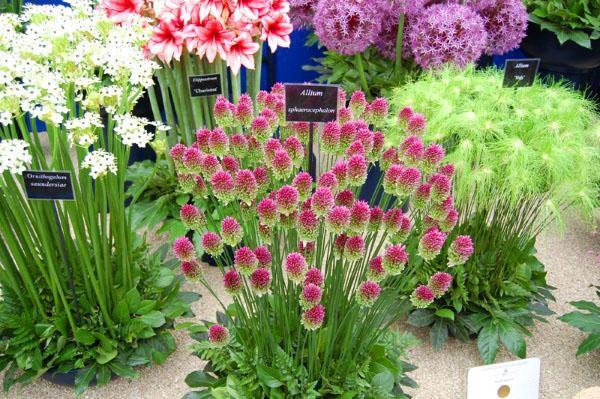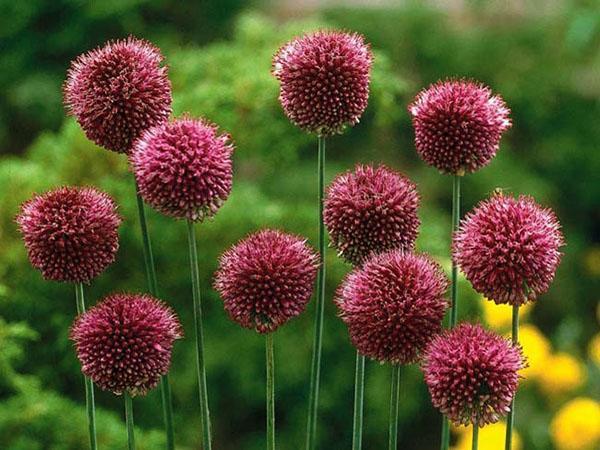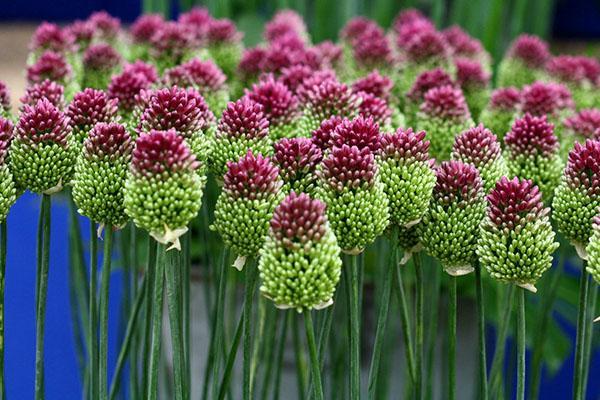Photo and description of allium varieties

The Allium flower grows mainly in the countries of the northern hemisphere, but an abundance of the plant can be observed in Chile, Brazil and in some African countries. Studying allium from a photo, it is impossible to restrain a smile - the appearance of a flower is similar to an overgrown and blooming onion. Unlike a vegetable, in the formed flower umbrella, you can spot a small bulb - no more than 5 mm in diameter. They are dark in color and often replace variegated flowers.
At the moment, the decorative allium onion has about a thousand species and varieties, differing in the shape and size of the flowers. All of them gather in umbrellas, which makes the flower bed look like a large accumulation of balls. Depending on the variety and region, the height of the flowers varies from 5 cm to 1.5 m. For the outlook and selection of the most suitable variety for self-cultivation, it is necessary to study the most common species.
Allium roundhead (sphaerocephalon)

The arrow of the round-headed allium can grow up to 60 cm in height with an inflorescence of at least 5 cm in diameter. The flower's umbrella is dense, goes well with ornamental greenery planted between the bulbs.
 The flower grows well in loose soils, while tolerating the winter without the need to dig out the bulbs. Allium Spherocephalon is enough to cover with a special material and sprinkle with fallen leaves.
The flower grows well in loose soils, while tolerating the winter without the need to dig out the bulbs. Allium Spherocephalon is enough to cover with a special material and sprinkle with fallen leaves.
Allium Roseum (roseum)
 The presented type of flower is the opposite of the above described variety. Its formed umbrellas are scattered, with the presence of light pink flowers. The flowers are large in diameter, can reach up to 1.5 cm. Allium Roseum inflorescences grow up to 60 cm in length. The plant grows mainly along the Mediterranean coast.
The presented type of flower is the opposite of the above described variety. Its formed umbrellas are scattered, with the presence of light pink flowers. The flowers are large in diameter, can reach up to 1.5 cm. Allium Roseum inflorescences grow up to 60 cm in length. The plant grows mainly along the Mediterranean coast.
The presented type of bulbous plant is one of the few that has thin leaves, reaching a width of only 1 cm.The buds are located on a thin stem.
Allium Purple Sensation
 The flower got its name due to its color - dense umbrellas with a large number of small flowers with six petals. Allium's variety Pearl Senseishen is actively grown in the gardens of Russian flower growers. Most are attracted by unpretentiousness, as well as the ability to grow even in the harsh climate of the country.
The flower got its name due to its color - dense umbrellas with a large number of small flowers with six petals. Allium's variety Pearl Senseishen is actively grown in the gardens of Russian flower growers. Most are attracted by unpretentiousness, as well as the ability to grow even in the harsh climate of the country.
The plant can grow in the shade, tolerates winters. It reaches a height of up to 1.5 m (the minimum height is 1.2 m), the allium purple sensation inflorescences are up to 12 cm in diameter.
Allium Gladiator
 The presented variety is similar in its characteristics to a vegetable familiar to a person. It grows up to 1 m with inflorescences 20 cm in diameter. The umbrella is dense, contains flowers with six petals. Allium Gladiator differs from the rest with its persistent aroma. Despite the similarity with a vegetable, this variety is whimsical to care for, therefore it is mainly grown in greenhouse or in the arboretum.
The presented variety is similar in its characteristics to a vegetable familiar to a person. It grows up to 1 m with inflorescences 20 cm in diameter. The umbrella is dense, contains flowers with six petals. Allium Gladiator differs from the rest with its persistent aroma. Despite the similarity with a vegetable, this variety is whimsical to care for, therefore it is mainly grown in greenhouse or in the arboretum.
The Gladiator variety is not only similar in structure and characteristics to a vegetable onion, but is also edible. Not the trunks are eaten, but the leaves of the plant.
Allium Ivory Queen
 Allium Ivory Queen is planted in the gardens of Russia quite often, which is explained by their unpretentiousness in care, as well as with a small growth - the shoots reach a maximum of 35 cm.The flower pleases with large inflorescences - up to 12 cm.The color of the buds is white, milky, ivory.
Allium Ivory Queen is planted in the gardens of Russia quite often, which is explained by their unpretentiousness in care, as well as with a small growth - the shoots reach a maximum of 35 cm.The flower pleases with large inflorescences - up to 12 cm.The color of the buds is white, milky, ivory.
The green-blue tint of the leaves and the endless aroma give the plant a special charm. Allium begins to bloom in mid-July, the buds can be seen within a month.
Allium Giganteum or giant
 The name of the flower fully justifies itself. The plant reaches at least 1.5 m in height, which is shown in the photo allium. Inflorescences of a lilac and bright purple shade with a diameter of 8 cm. The shape of the flower is interesting - this is a star familiar to everyone, rather small for a dense umbrella. Flowering begins in the middle or towards the end of summer, pleases flower growers for a month.
The name of the flower fully justifies itself. The plant reaches at least 1.5 m in height, which is shown in the photo allium. Inflorescences of a lilac and bright purple shade with a diameter of 8 cm. The shape of the flower is interesting - this is a star familiar to everyone, rather small for a dense umbrella. Flowering begins in the middle or towards the end of summer, pleases flower growers for a month.
Allium Giganteum is contrasted - its tall pillar does not "match" the leaves. They are squat, wide and quickly turn yellow.
Allium the City-loving
 This variety is classified as a low-growing plant, since its height reaches only 10-20 cm in height. The flower bulbs are small, no more than a pea. The inflorescences contain flowers that are more similar in shape to the familiar bells. The umbrellas are not dense, so the flowers can be counted - there are no more than 40 of them.
This variety is classified as a low-growing plant, since its height reaches only 10-20 cm in height. The flower bulbs are small, no more than a pea. The inflorescences contain flowers that are more similar in shape to the familiar bells. The umbrellas are not dense, so the flowers can be counted - there are no more than 40 of them.
Allium Gorophilous grows in central Russia, blooms at the end of May and pleases the eyes for only 20 days.
Allium Moli
 In the gardens of Russian flower growers, you can find a small plant with numerous yellow and loose umbrellas. The flower is no more than 25 cm tall, begins to bloom from late May to early June. This is allium Moli, which pleases with unpretentious cultivation and the shape of yellow flowers - the usual stars.
In the gardens of Russian flower growers, you can find a small plant with numerous yellow and loose umbrellas. The flower is no more than 25 cm tall, begins to bloom from late May to early June. This is allium Moli, which pleases with unpretentious cultivation and the shape of yellow flowers - the usual stars.
Allium Sativum (Sativum)
 Most will be surprised, but the allium shown in the photo is garlic. From the point of view of the study of plant species, it is the Allium Sativum variety, the bulbs of which are edible. Umbrellas are small in diameter and predominantly contain unopened buds of white small flowers. Gradually, the flowers change their shade to gray. Flowering is often stopped by the desire of the gardener - he simply pulls out the inflorescences, collecting the bulbs for practical purposes.
Most will be surprised, but the allium shown in the photo is garlic. From the point of view of the study of plant species, it is the Allium Sativum variety, the bulbs of which are edible. Umbrellas are small in diameter and predominantly contain unopened buds of white small flowers. Gradually, the flowers change their shade to gray. Flowering is often stopped by the desire of the gardener - he simply pulls out the inflorescences, collecting the bulbs for practical purposes.
Allium Mixed (Mixed)
 Breeders are actively using the flower in question to breed new varieties. So Allium Mixed is one of the results of the creative activity of specialists, called the Low-growing mixture. The plant really reaches a height of no more than 25 cm.
Breeders are actively using the flower in question to breed new varieties. So Allium Mixed is one of the results of the creative activity of specialists, called the Low-growing mixture. The plant really reaches a height of no more than 25 cm.
Mixed is chosen by those amateur flower growers who like to create landscapes with long flowering in their flower beds. This artificially bred variety blooms from June to August, unlike other varieties that can keep flowers for a maximum of 25-27 days.
Features of home care
 If there is a desire to plant the presented decorative flower with the alleged consumption of certain varieties, it is necessary to study the features of self-cultivation at home. The following features of planting and care are distinguished here:
If there is a desire to plant the presented decorative flower with the alleged consumption of certain varieties, it is necessary to study the features of self-cultivation at home. The following features of planting and care are distinguished here:
- Choosing a landing site. These are extremely dry places with a lot of light. There are some varieties that can withstand shade, but the brightness of the umbrellas depends on the lighting. Therefore, it is best to choose places that are in direct sunlight most of the time.
- Landing. It is necessary to plant the bulbs in the fall - from September to October. The soil should be fertile and loose. To do this, you can add a little sand while digging the soil. For a better habituation of the bulbs, it is recommended to add mineral fertilizers suitable for the bulbous plants. Planting is carried out in pre-prepared holes with a depth of 2 bulb diameters. The distance between the holes is at least 30 cm.
- Care. Allium needs to be watered as the topsoil dries.Since the plant is bulbous, a large amount of moisture is destructive for it. During cultivation, it is enough to weed the planted area and loosen the ground.
- Top dressing. The flower must be fertilized 3 times during its growth and flowering. The first time in the spring, as soon as the first shoots appear. These must be special mineral fertilizers. During flowering, formulations intended for flowering plants are chosen for feeding. In autumn, phosphorus-potassium fertilizers are applied. It is also recommended to add wood ash to the soil when planting bulbs in the fall.
- Reproduction. The bulbous flower is propagated only by daughter bulbs. They are separated from the main one, and then planted in closed ground until next fall. In a year, the bulb will grow and gain strength. Landing is also carried out before winter.
- Diseases and pests. The flower is susceptible to fungal diseases - powdery mildew or cervical rot. This often happens if the dug out bulbs were stored improperly during the winter at home. The disease is quickly transferred to healthy bulbs - they become softer and dry out. It is unacceptable to plant them in the ground. To avoid infection, the bulbs are kept at a temperature of +40 for 112 hours. Onion fly, moth and spider mite are isolated from pests. If appropriate traces appear on the plants, you must use a chlorophos solution.
 Allium is a perennial plant that can be in the garden of a florist for 5 years. There is no need to dig up the bulbs every winter. The beauty shown in the photo of allium inspires self-cultivation, which even a novice florist can handle. If there are notes of doubt, you can try planting undersized varieties at home. After flowering, the bulbs can be removed from the ground, wrapped in newspaper separately and put into the refrigerator. In autumn, it is allowed to plant them in open ground in accordance with the recommendations presented above.
Allium is a perennial plant that can be in the garden of a florist for 5 years. There is no need to dig up the bulbs every winter. The beauty shown in the photo of allium inspires self-cultivation, which even a novice florist can handle. If there are notes of doubt, you can try planting undersized varieties at home. After flowering, the bulbs can be removed from the ground, wrapped in newspaper separately and put into the refrigerator. In autumn, it is allowed to plant them in open ground in accordance with the recommendations presented above.